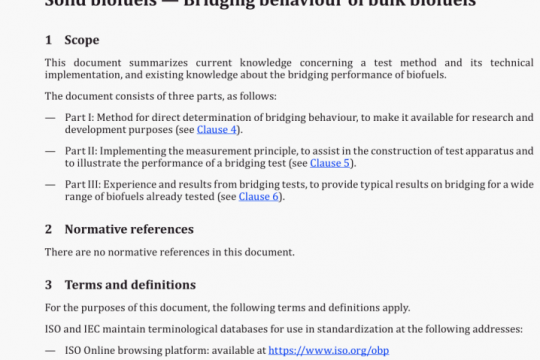ISO 14620-3 pdf free download
ISO 14620-3-2021 pdf free download.Space systems一Safety requirements一 Part 3: Flight safety systems.
5.2 All spent stages shall incorporate tracking devices or establish means of tracking that enable realtime monitoring of vehicle position and velocity, except when pre-flight analysis establishes that the stage separation activity will not result in an unknown or hazardous impact area or dispersion.
5.3 All launch vehicles shall incorporate TDTSs for monitoring vehicle performance data and the FTS and tracking system status that are capable of functioning throughout the launch phase until the end of range safety responsibility
5.4 Any launch vehicle having a stage, motor or component capable of violating the defined safety envelope shall be equipped with an FTS that interrupts the flight of the vehicle if it diverts from its predicted flight trajectory and has sufficient energy to become a threat to public safety.
5.5 All the FTSs, telemetry and tracking systems of launch vehicles shall be compatible with applicable spaceport and/or range ground equipment.
5.6 The inability to accurately ascertain the vehicle’s position shall be a criterion for stopping the launch countdown.
5.7 lIthe ability to accurately determine the location of the vehicle is lost after launch, this normally requires initiation of FTS action, unless otherwise specified in the mission rules or range safety operational procedures.
5.8 For launch vehicles and payloads containing radioactive materials, proof of compliance with all appropriate regulations governing radioactive materials shall be provided.
6 Flight termination system requirements
6.1 General
6.1.1 Any launch vehicle where a malfunction of the vehicle or any stage, motor, payload or component can generate an unacceptable hazard to public safety shall contain FTSs.
6.1.2 All launch vehicle stages capable of violating the defined flight safety envelope shall contain FTSs.
6.1.3 The FTS flight equipment reliability shall be not less than 0,999 or shall conform to quantitative flight safety requirements as required in ISO 14620-2, if the latter requirements are more stringent. This reliability should be established by analysis of all components and supporting test data. The reliability of FTS ground equipment (including the radio-frequency propagation path as far as the launch vehicle) shall be compatible with the reliability requirements of the flight hardware.
6.1.4 The FTS, including monitoring and checkout circuits, shall be designed to eliminate the possibility of an SFP inhibiting the function of the system or causing an undesired output of the system. This requirement shall be verified by performing an SFP analysis.
6.1.5 The FTS shall make non-propulsive all propulsive systems of the vehicle.
6.1.6 The liquid propellant system shall meet the following requirements:
a) The FTS of a liquid propellant launch vehicle shall provide engine shutdown and inhibition ot further engine start. This can be the result of the destruction of each stage.
b) A rapid burning or explosion caused by the destruct capability of toxic propellants shall be initiated to consume as much propellant as possible before impact.
6.1.7 The solid propellant system shall meet the following requirements:
a) The FTS destruct charges of a solid propellant vehicle shall be designed to destroy the pressure integrity of the motor and ignite any non-burning propellant.
b) The destruct action shall cause a condition of zero thrust, zero lift and zero yaw; if not. any residual thrust shall cause a tumbling action such that no significant lateral or longitudinal deviation of the impact point can result.
6.1.8 The FTS shall be designed such that termination action of one stage will not sever or inhibit functioning al FTS circuitry or ordnance on other stages.
6.19 The FTS shall be designed to function properly in the environment (shockwave, heatwave, etc.) resulting from the vehicle break-up.
6.1.10 FTS components shall be independent of any other system on the vehicle or payload to the extent that normal or abnormal functioning of the other vehicle components does not inhibit or activate the FTS components.
6.1.11 FTS components shall be isolated from other vehicle components to the extent that normal or abnormal functioning of the other vehicle components does not inhibit or activate the FTS components.
6.1.12 FTS active components, electrical cables, batteries, ordnance lines and destruct charges shall be redundant unless otherwise approved by the launch site country.
6.1.13 Redundant ordnance components, signal cables and electrical power cables shall be physically separated from each other by the maximum distance possible and mounted in different orientations, or on different axes where technically feasible.
6.1.14 FTS electrical and ordnance components shall have their operating and storage life specified.
6.1.15 The launch vehicle operator shall verify the FTS has sufficient service life for the specified mission prior to launch.
6.1.16 For externally controlled FTSs, antenna, receivers and decoders shall be compatible with the used GSE (gain, coverage, operating frequencies, bandwidth and insertion loss).
6.1.17 For externally controlled FTSs, all equipment shall be designed or chosen to ensure a radio- frequency propagation path from the command transmitter/antenna system to the launch vehicle antenna.
6.1.18 For externally controlled FTSs, the response time of each equipment from the receipt of signal shall be enough short to be capable to maintain safety envelop.
6.1.19 For externally controlled FTSs, the FTS antenna system shall cover more than 95 % of the radiation sphere.
6.1.20 The FTS shall conform to the qualitative safety principles described in ISO 14620-2 and be subjected to a safety analysis as described in ISO 14620-1.
6.2 Flight termination system sale and arm devices
6.2.1 For launch vehicles in which propulsive ignition occurs before first motion, the FTS S&A devices
shall be armed prior to arming launch vehicle and payload ignition circuits.ISO 14620-3 pdf download.




